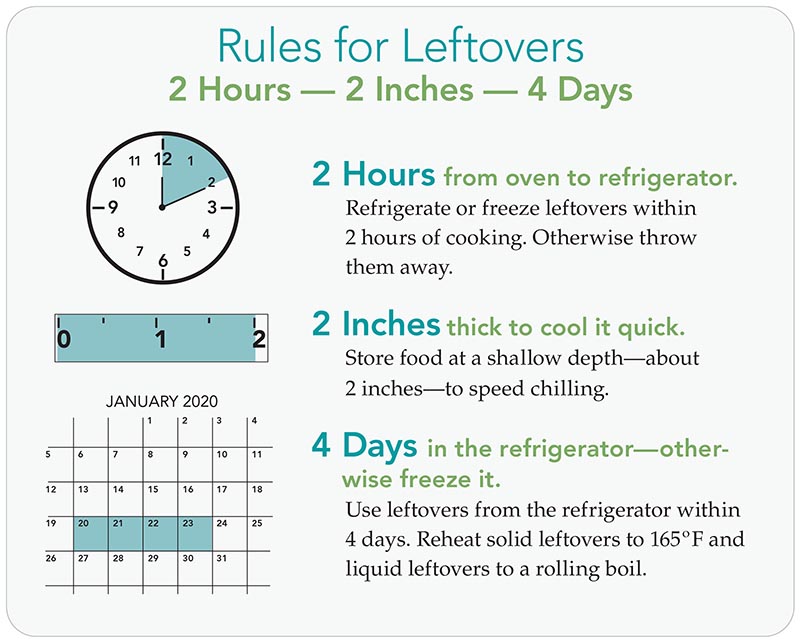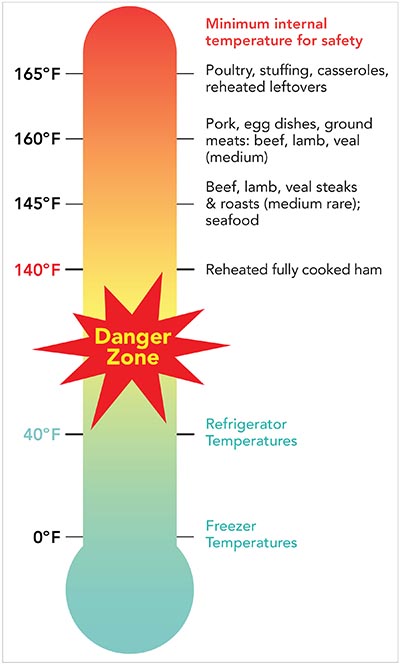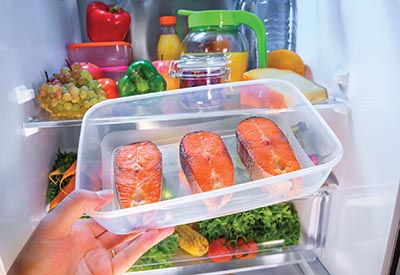10 myths about food poisoning

Do you throw out milk the day it hits its expiration date? Or assume it’s unsafe to refreeze thawed meat? And when was the last time you sanitized your sponge? Here are 10 food safety myths that may surprise you.
Myth #1: The sniff test works.
Got food that’s slimy or smelly?
“That’s due to spoilage bacteria,” explains Maribel Alonso, a technical information specialist at the U.S. Department of Agriculture.
“Those bacteria can grow at refrigerator temperatures, but typically they won’t make you sick.”
What will? “You can get really sick from pathogenic bacteria like E. coli O157:H7, Salmonella, and Clostridium perfringens,” says Alonso. “They grow best at room temperature, but they won’t cause your food to smell or taste bad.”
One notable exception: “Listeria monocytogenes grows at refrigerator temperatures,” says Alonso.
Listeria typically grows on deli meats, smoked fish, and prepared foods. It’s responsible for listeriosis, the hard-to-diagnose infection that can cause miscarriage in pregnant women and symptoms like fever, diarrhea, headache, and stiff neck.
Bottom Line: Don’t rely on your nose (or eyes) to detect harmful bacteria.
Myth #2: If it’s past the “best by” date, toss it.
Food packages often list a “sell by,” “best by,” “enjoy by,” or “expiration” date.
But if you don’t “enjoy by” that date, does it mean you’ll get “sick after”?
Nope.
Dates on food labels are the manufacturers’ best guess about how long a food will taste freshest. After that date, the quality gradually declines.
“Most foods would become quite unpalatable before they would be unsafe to eat,” says Roni Neff, director of the food system sustainability & public health program at the Johns Hopkins Center for a Livable Future.
It’s not time that makes most foods unsafe, notes Neff. It’s that they become contaminated with bacteria from raw meat or poultry and aren’t kept cold enough or cooked thoroughly.
Part of the confusion is that many people think that the government regulates expiration dates. (Other than for infant formula, it doesn’t.)
That can also lead to waste.
“People who believe that date labels are federally regulated are more likely to throw out food on a precautionary basis,” says Neff. Ditto for those who think that “outdated” foods are unsafe.1
In 2017, the food industry urged companies to use only one of two terms on packages: “BEST if used by” and “USE by.”
(Congress is considering the Food Date Labeling Act, which would require one of those two terms on foods that carry expiration dates. Many companies are already using them.)
“The ‘BEST if used by’ label is meant to be about quality,” explains Neff. “The ‘USE by’ label is meant to be about whether the food is safe.”
Which foods would get which label?
“Most foods will not need a label at all, or they would get the ‘BEST if used by’ label,” says Neff.
“The few foods that become unsafe because of time would get a ‘USE by’ label. It’s mainly for foods where Listeria is a concern, because it can grow under normal storage conditions.”
Bottom Line: Be more wary of pathogens if a food is past its “USE by” date.
Myth #3: Reheating leftovers kills bacterial toxins.
“When we leave leftovers out, it’s a perfect environment for bacteria to thrive,” says the USDA’s Maribel Alonso.
“Bacteria can double in as little as 20 minutes at temperatures between 40 and 140 degrees—what we call the food safety ‘danger zone,’” she adds.
“If you don’t put leftovers away within two hours after cooking, toss them. And if you’re outside and it’s warmer than 90 degrees, food needs to be refrigerated within one hour.”
Doesn’t reheating kill off those pesky bacteria? “Yes,” says Alonso. “But some bacteria, like Staphylococcus aureus and Clostridium perfringens, produce toxins that are heat resistant.”
Bottom Line: Leftovers left out too long? Toss them.

Myth #4: Sanitize sponges when they start to smell.
“A moist sponge that is not sanitized daily or replaced often can harbor bacteria and germs that can make you sick,” says Mindy Costello, an environmental health expert and registered sanitarian at NSF International, a nonprofit organization that certifies appliances, food equipment, water filters, and more.
“In our survey of Michigan households, 86 percent of sponges and dishcloths had yeast and mold, 77 percent had coliform bacteria, and 18 percent had Staph bacteria.”2 Yikes.
Costello’s advice: “As long as it doesn’t contain any metal, microwave your damp sponge for two minutes every day.”
But no matter how you slice it, sponges have a short lifespan. “We recommend throwing them out every two weeks,” says Costello. (Tip: Cut ordinary sponges in half to use fewer over time.)
A less wasteful option: Use a dish brush. Just soak it for a minute every night in diluted bleach (one tablespoon of bleach in one gallon of water), then rinse and air dry. (NSF International hasn’t tested the bleach method on sponges.)
To clean kitchen surfaces, use a fresh dishcloth every day. “They can be easily washed with bleach in a washing machine,” Costello notes.
Bottom Line: Whether you use a sponge, dish brush, or dishcloth, sanitize it daily.
Myth #5: You can slow-cook frozen food.
“Food should be completely thawed before you put it in a slow cooker,” says the USDA’s Maribel Alonso. “If you put in a block of frozen food, it may take too long for the food to reach a safe temperature.”
In other words, the food may spend more than two hours in the “danger zone.”
And if your slow cooker has a “delayed start” feature, think twice before you use it. If the food sits in the cooker at room temperature for more than two hours, you’re smack in the danger zone.
Instead, get a slow cooker that automatically switches to “warm” after the food is cooked.
Bottom Line: Never let food spend more than two hours in the “danger zone.”

Myth #6: You can’t refreeze thawed raw meat.
Dinner plans changed? “As long as you’ve thawed raw meat, poultry, or seafood in the refrigerator, you can refreeze it,” explains Alonso.
(If you’re short on time, you can put frozen meat in a leak-proof plastic bag and submerge it in cold water on your counter, replacing the water every 30 minutes. But unlike meat thawed in the fridge, you’ll need to cook it immediately.)
And any cooked meat can be refrozen.
The catch: Raw meat that has been refrozen won’t taste as good.
“When the meat is thawed, you lose moisture,” says Alonso. “Add another freeze-thaw cycle, and the consistency and tenderness of the meat will change.”
Bottom Line: It’s safe to refreeze raw meat that was thawed in the fridge.

Myth #7: Unsafe food only affects your GI tract.
Bacteria in food may be a culprit in urinary tract infections, or UTIs.
“We think some of the bacteria that cause UTIs are coming from animal foods,” says Lee Riley, chair of the division of infectious diseases and vaccinology at the University of California, Berkeley.
For nearly two decades, Riley and others have found links between bacterial strains in animal foods—mostly poultry—and those that cause UTIs.3-5
How do bacteria from animals reach your urinary tract? First, people may touch kitchen counters, utensils, or their hands after touching raw poultry or meat, and the bacteria end up on salad or other raw foods.
When people ingest those bugs, “the bacteria transiently colonize the intestine,” says Riley. “In some people, they make their way out and cause a UTI.”
Some of his evidence: “We looked at the genetic fingerprints of E. coli in urine samples from Berkeley students with a UTI.6 At the same time, we collected meat and poultry samples from the supermarkets around Berkeley. Twelve of the 61 distinct genetic fingerprints of E. coli from the UTI cases were also found in the meat or poultry samples.”
Those studies don’t prove that bacteria from meat is causing the UTIs, but the evidence is troubling.
“Based on our data, 20 percent of UTIs in Berkeley may have an animal food origin,” says Riley. “If that’s true, it’s a major public health issue.”
But the government doesn’t keep tabs on UTIs or the bacteria that cause them.
“The CDC already tracks other foodborne pathogens,” Riley notes. “Why not include UTIs? Then we could learn more about the disease, and if it’s truly associated with food.”
Unfortunately, UTIs are not always easy to treat with a round of antibiotics.
“We’re seeing progressive increases in drug-resistant UTIs,” says Riley.
And, again, food may be a source. A 2018 study identified a strain of antibiotic-resistant E. coli both in urine samples from people with UTIs and in meat samples from nearby grocery stores.5
Bottom Line: Keep a separate cutting board for raw meat, poultry, and seafood. After you handle them, wash your hands and utensils thoroughly. “And look for meat raised without antibiotics, which may minimize your exposure to drug-resistant bacteria,” says Riley.
Myth #8: All eggs need to be refrigerated.
Store-bought eggs must be refrigerated from farm to table. But if they’re fresh off the farm, it’s a different story.
“Commercial eggs are washed at a processing plant,” says the USDA’s Maribel Alonso. Washing removes dirt and bacteria from the eggs’ shells, she adds, “but it also eliminates the ‘bloom.’”
That’s the natural coating that helps keeps water in and bacteria like Salmonella out.
“The washed shell is porous, so anything on the outside can contaminate the inside,” explains Alonso. Once the bloom is gone, refrigeration keeps Salmonella from growing.
And once eggs have been refrigerated, they need to stay there. A cold egg left at room temperature can “sweat,” which opens the shell’s pores.
But bloom or no bloom, eggs last longer in the fridge.
(To kill Salmonella, cook eggs until both the white and yolk are firm. Like a runny yolk? Try pasteurized eggs, which have been treated to kill Salmonella.)
Bottom Line: Refrigerate store-bought eggs.
Myth #9: Hand sanitizer kills all germs.
“Kills 99.99% of germs,” boasts the label of Germ-X hand sanitizer. But are most of those germs harmless? The FDA has asked companies for more evidence.
Alcohol-based hand sanitizers like Germ-X won’t kill bugs like the parasite Cryptosporidium, or the hard-to-treat bacteria Clostridium difficile, which can cause life-threatening diarrhea.
Nor will they kill norovirus, which is highly contagious and causes vomiting, diarrhea, and nausea.
Norovirus is the leading cause of foodborne illness in the United States. The Centers for Disease Control and Prevention estimates that each year, 19 to 21 million Americans get sick from norovirus (though not all of them from eating contaminated food).
Bottom Line: Hand-washing is a safer bet than hand sanitizer.
Myth #10: Eating raw dough is fine if you make it with pasteurized eggs.
Raw batter or dough made with raw eggs can harbor Salmonella. But it’s not just the eggs that can get you.
In two recent outbreaks, contaminated raw flour sickened 84 people with Shiga toxin-producing E. coli, which can cause bloody diarrhea.
The bacteria most likely got into the flour in the field or during processing.
“Make sure that you wash your hands, work surfaces, and utensils with warm water and soap after handling raw flour,” says Alonso.
Bottom Line: Don’t taste raw dough or let kids play with homemade playdough.
1Waste Manag. 86: 123, 2019.
2 nsf.org/newsroom_pdf/2011_NSF_Household_Germ_Study_exec-summary.pdf.
3Clin. Infect. Dis. 40: 251, 2005.
4Clin. Infect. Dis. 61: 892, 2015.
5MBio. 9: e00470-18, 2018.
6mSphere 3: e00179-18, 2018.
Illustrations: Jorge Bach/CSPI (top), adapted from U.S. Department of Agriculture (thermometer, leftovers). Photo (refrigerator): Andrey Armyagov/stock.adobe.com.
Tags
Topics

